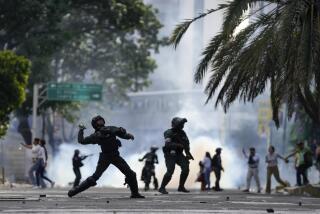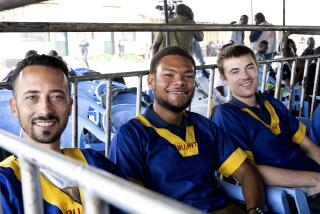From putschist to el presidente in Latin America
FOR REBELS, the rewards of a successful coup d’etat seem obvious: They seize political power and run the country. The consequences of failure seem equally clear: jail, exile, even execution. Except in the Andean countries of Venezuela, Ecuador and possibly Peru, where an unsuccessful coup attempt can be the first step on the road to winning the presidency. Consider:
On Feb. 4, 1992, Venezuelans anxiously await news of a military coup unfolding in three cities. President Carlos Andres Perez, shaken but confident that his government’s troops are defeating the rebels, decides to allow the leader of the military revolt to address the nation on television in hopes of quelling lingering resistance.
Wearing a red beret and looking fit, Lt. Col. Hugo Chavez takes to the airwaves and calls for his men to surrender. “This time,” he says, “we failed to take control of Caracas.”
But Chavez was hardly defeated. From his jail cell, he began preparing his political campaign for the presidency and, once released, was more popular than the most famous of Venezuelans, baseball player and manager Ozzie Guillen. The former rebel easily won the 1998 presidential election, and a plebiscite in 2000 confirmed his hold on power. Since then, he has hinted on numerous occasions that he might stay in power until 2021.
Switch to Ecuador, Jan. 21, 2000. It’s early morning in Quito, the capital. After several days of protesting official corruption in the city’s streets, large groups of indigenous people take over the Congress, with the acquiescence of the military. When the country’s top generals withdraw their support for President Jamil Mahuad, a little-known army colonel named Lucio Gutierrez enters the National Palace alongside the leader of the Confederation of Indian Nations and a former Supreme Court president. Together they form a triumvirate that will govern the country.
Within 24 hours, intense U.S., international and domestic pressure forces Ecuador’s military leaders to cast the triumvirate aside and recognize the constitutional authority of the vice president to become president. Gutierrez is arrested and serves six months in jail. But two years later, Gutierrez renews his political alliance with the Indians and is elected president of Ecuador. (He was removed from office by Congress two years later.)
Like Chavez and Gutierrez, Col. Ollanta Humala was involved in a failed coup attempt in Peru.
In October 2000, in the mining town of Toquepala in southern Peru, Humala leads a small military uprising against President Alberto Fujimori and Vladimiro Montesinos, the dreaded former intelligence chief. The revolt rapidly fizzles, but Humala is praised in the local press for his courage to take on Fujimori against long odds. Humala goes into hiding, and his popularity soars.
After Fujimori is impeached later that year, Congress pardons the rebels, and Humala rejoins the military. Fearful of his popularity, the government sends him on diplomatic missions to Paris and South Korea in the hope he’ll be forgotten, but to no avail.
This year, Humala launched his campaign for the presidency, winning the first round of voting, and chances are he may win the runoff this month.
Nowhere else but in the Andean region of Latin America have leaders of a failed coup gone on to win election as president. Only in Venezuela, Ecuador and Peru have botched coup attempts bestowed the kind of name recognition invaluable for a political career.
Many factors help explain this recent Andean phenomenon -- among them, the region’s extreme poverty, distrust of the corrupt traditional political parties and the relatively good reputation of the countries’ militaries. Perhaps more important is that the racial and indigenous groups that traditionally have been excluded from politics are increasingly reshaping these societies. In Ecuador and Peru, indigenous Indians make up nearly half the population. Venezuela, Ecuador and Peru all have mestizo majorities. By contrast, the populations of Argentina, Uruguay and Chile are overwhelmingly white.
Chavez, Gutierrez and Humala are all mestizos. They look, act and talk like their countries’ majorities, and when you add their charisma, they become formidable political forces.
Their political survivability may also have historical roots. After the wars of independence against Spain in the first half of the 19th century, liberal elites struggled to create new nations modeled along European lines. But they gave no dignified role to the indigenous communities that actually owned the land. They were excluded. As a result, “nowhere in Latin America were post-colonial transitions more vexed or violent than in the Andes, where communal indigenous roots grew deep and where the ‘Indian problem’ seemed so daunting to liberalizing states,” says historian Brooke Larson in “Trials of Nation Making.”
The rise of Chavez, Gutierrez and possibly Humala from failed rebels to presidents may be the modern counterpart of that unresolved 19th century conflict of liberalism and racism.
More to Read
Sign up for Essential California
The most important California stories and recommendations in your inbox every morning.
You may occasionally receive promotional content from the Los Angeles Times.










